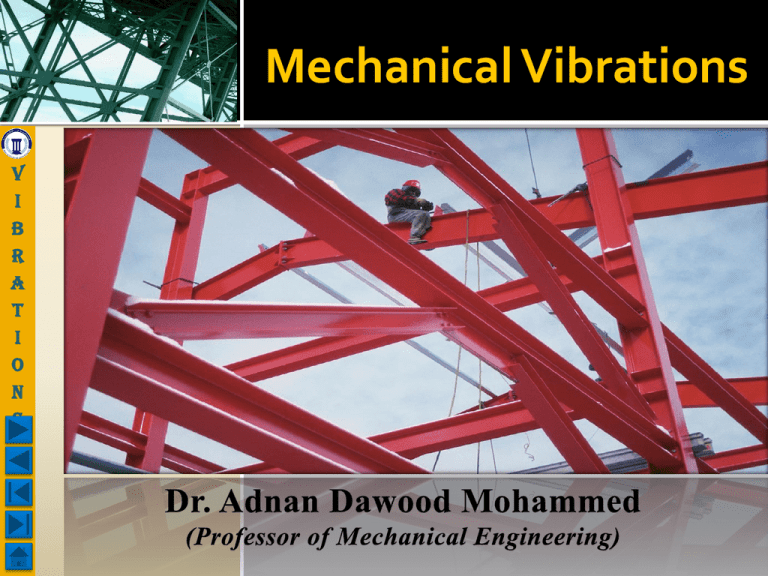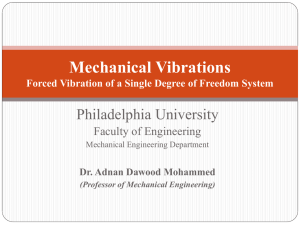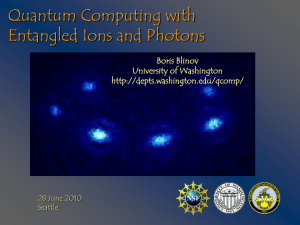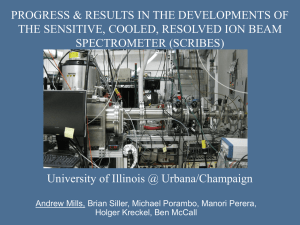Undamped Single Degree of Freedom System
advertisement

Mechanical Vibrations v i b r a t i o n s . v i b r a t i o n s . Introduction 1 v i b r a t i o n s . Examples v i b r a t i o n s . Examples v i b r a t i o n s . Equation of motion Equation of motion Newton's 2nd law of motion Other methods D’Alembert’s principle Virtual displacement Energy conservation v i b r a t i o n s . Newton's 2nd law of motion Draw the free-body diagram Apply Newton s second law of motion Determine the static equilibrium configuration of the system Select a suitable coordinate The rate of change of momentum of a mass is equal to the force acting on it. v i b r a t i o n s . Newton's 2nd law of motion .. d d xt d 2 xt F t m m mx 2 dt dt dt .. .. F t kx m x m x kx 0 Energy conservation Kinetic energy 1 .2 T mx 2 Potential energy 1 U kx 2 2 T U const ant d T U 0 dt .. m x kx 0 v i b r a t i o n s . Vertical system .. m x k x st m g ; m g k st .. m x kx 0 v i b r a t i o n s Solution to the equation of motion: mx kx 0 (1), it a homogenuos2nd order ordinarydifferental i equat ion.Equat ion(1) can be writ t enas, x n2 x 0 where n k / m is t heknown as t henat ural frequency solut ion o t equat ion (1) may has t hesolut ion of t he t ype: x(t ) Best where B is const antand S are t heroot sof solut ion. subst it ut e t hesolut ionint oeqat ion(1) yields : ( s 2 n2 ) Best 0 . or s 2 n2 0 e st 0 i.e v i b r a t i o n s . s j n T hesolut ion ot equation (1) can now be writtenas : x(t ) B1e jnt B2 e jnt Note that: e jnt cosnt j sin nt , Therefore x(t ) ( B1 B2 ) cosnt j ( B1 B2 ) sin nt P ut A1 B1 B2 and A2 j ( B1 B2 ) T hen x ( t ) A 1c o sω n t A 2 s inω n t (2) T hesolut ion ot equat ion (1) can also be writ t enin t heform: v (3) x ( t ) Ac o s ( ω n t φ ) i b r a t i o n s . W hereA t an1 A12 A22 is t heamplit udeof mot ionand A2 is t hephase angle. A1 t free vibrat ionof t hesyst emconsist sof a harmonicmot ion we can say t hat he of an amplit ude A and frequancyn . Note : T heconst ant sA1 and A2 (or A and ) can be obt ainedfrom applyinginitial conditionsof t hemot ion. Inat ialcondit ions: v i b r a t i o n s . . . Let at t 0 ; x(t ) X 0 and x(t ) X 0 . Sust it ut ing t hese condit ionsint o t hegeneralsolut ion(2) or (3) yields : . A1 X 0 and A2 X0 n t hen t hegeneralsolut ionbecomes: . X0 x(t ) X 0 cosnt sin nt ........(4) ω n T heamplit udeA and t hephaseangle φ become: 2 . . X0 2 X0 1 A X0 and t an X 0ωn ω n Equat ion(4) can be used t o obt ain t hevalue of displacement of t he syst emunder consideration at any t imet. v i b r a t i o n s . Graphical representation x(t ) = A cos(ωnt – ϕ ) v i b r a t i o n s Torsional vibration A systemhas a shaft of torsionalstiffness K t and a disk of momentof ineria J D as shown. Note that thestiffness of theshaft is calculatedas; d4 Kt where I p is the polar moment of ineria. L 32 ApplyingNewtons 2 nd law : M 0 J GI p D K t J D J D K t 0 is theequation of motion and from which thenaturalfrequencycan be obtainedas n . Kt rad/sec. JD v i b r a t i o n s . Natural Frequency (ωn) : It is a system property. It depends, mainly, on the stiffness and the mass of vibrating system. It has the units rad./sec, or cycles/sec. (Hz) It is related to the natural period of oscillation (τn) such that, τn = 2π/ωn and ωn = 2 π fn where fn is the natural frequency in Hz. v i b r a t i o n s . Example 2.1 The column of the water tank shown in Fig. is 90m high and is made of reinforced concrete with a tubular cross section of inner diameter 2.4m and outer diameter 3m. The tank mass equal 3 x 105 kg when filled with water. By neglecting the mass of the column and assuming the Young’s modulus of reinforced concrete as 30 Gpa. determine the following: the natural frequency and the natural period of transverse vibration of the water tank the vibration response of the water tank due to an initial transverse displacement of tank of 0.3 m and zero initial velocity. the maximum values of the velocity and acceleration experienced by the tank. v i b r a t i o n s . Example 2.1 solution: Initial assumptions: 1. the water tank is a point mass 2. the column has a uniform cross section 3. the mass of the column is negligible v i b r a t i o n s . Example 2.1 solution: a. Calculation of natural frequency: 1. Stiffness: k 3EI , But: I 3 l d 64 4 o d i4 3 64 4 2.4 4 2.3475 m 4 3x30x109 x 2.3475 289,812 N / m So: k 3 90 2. Natural frequency : n k 289,812 0.9829rad / s 5 m 3x10 v i b r a t i o n s Example 2.1 solution: b. Finding the response: 1. x(t ) = A cos (ωn t - ϕ ) 2 . Xo A X o2 X o 0.3m n So, . . 0 1 X o 1 0 tan tan X on X on x(t ) = 0.3 cos (0.9829 t ) v i b r a t i o n s . Example 2.1 solution: c. Finding the max. velocity: . xt 0.30.9829sin 0.9829t x (t ) is maximumwhen 0.9829t /2 then t /(2 * 0.9829) . x max 0.30.9829 0.2949m / s Finding the max. acceleration : .. 2 xt 0.30.9829 cos0.9829t .. xt is maximumwhen 0.9829t then t / 0.9829 .. 2 x max 0.30.9829 0.2898m / s 2 v i b r a t i o n s . Example 2.2 : Free vibration of single degree of freedom system Example 2.2 : solution Let t hedisplacement of t hecent resof pulleys1 and 2 are x1 and x 2 respect ively.T hefree body diagrams of t hepulleys show t hat: 2w k1 x1 and 2w k 2 x 2 where w mg. Not e t hat 2w 2w x 2 k2 k1 T hesyst emis equivalent t o a mass springsyst emof mass m x 2x1 2x2 or and st iffnessk eq such t hat w k eq x, t henby subst it ut ing for x t heequivalentst iffnessof t hesyst embecomes: k eq 1 k1k 2 , t heequat ion of mot ionis t hen 4 k1 k 2 mx k eq x 0, and t henat uralfrequencyis n k eq m v i b r a t i o n s . Simple pendulum Governing equation: M .. O J O J O .. J O m glsin 0 Assume θ is very small sin .. J O m gl 0 Natural frequency (ωn) JO m gl n 2 JO m gl v i b r a t i o n s . Solution t A1 cosnt A2 sinnt t 0 A1 o . t 0 . o A2n o , A2 n . . o t o cosnt sin nt n v i b r a t i o n s . Example 2.3 Any rigid body pivoted at a point other than its center of mass will oscillate about the pivot point under its own gravitational force. Such a system is known as a compound pendulum (as shown). Find the natural frequency of such a system. Solution v i the governing equation is found as: b .. r J O Wd sin 0 a Assume small angle of vibration: t .. i J O Wd 0 o n So: s Wd m gd n . JO JO v i b r a t i o n s . Example 2.5: Q2.45 Draw the free-body diagram and derive the equation of motion using Newton s second law of motion for each of the systems shown in Fig











